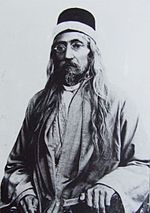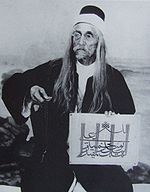- Mishkín-Qalam
-
Mírzá Ḥusayn-i-Isfahání (1826–1912) surnamed Mishkín-Qalam (مشكین قلم), (meaning either musk-scented pen, or jet black pen) was a prominent Bahá'í and one of the nineteen Apostles of Bahá'u'lláh, as well as a famous calligrapher of 19th century Persia. He is the author of a calligraphic rendering of the Greatest Name, used by Bahá'ís around the world.
Contents
Background
Mishkín-Qalam was born in Shíráz but was a resident of Isfahán, which is where he first heard of the Bahá'í Faith.[1] A few years later he travelled to Baghdad and learned in more detail from Zaynu'l-Muqarrabín and Nabíl-i-A`zam, but was not confirmed until he later travelled to Adrianople and met Bahá'u'lláh.[1]
Before becoming a Bahá'í, he was a Súfí of the Ni'matu'lláhí order.[1] He was also a skilled astronomer.[2]
Imprisonment
Mishkín-Qalam was sent by Bahá'u'lláh to Constantinople (Istanbul), where he began attracting people through his art and vigorously teaching the Bahá'í Faith. The Persian ambassador began to complain to the Sultan's vazirs and soon had him arrested.[2] When Bahá'u'lláh was exiled to `Akká, Mishkín-Qalam was exiled to Cyprus with the followers of Subh-i-Azal, where he remained a prisoner in Famagusta from 1868 to 1877.[1]
Cyprus eventually left Ottoman control and Mishkín-Qalam was released. He made his way to `Akká in 1886, and remained there until Bahá'u'lláh died in 1892, after which he travelled to Egypt, Damascus and India.[1] He remained in India until 1905, and then returned to Haifa until his death in 1912.[1]
Calligraphy
Mishkín-Qalam was a renowned calligrapher.[1] `Abdu'l-Bahá called him a second Mír `Imád, a 16th century calligrapher of the Safavid dynasty who is perhaps the most celebrated Persian calligrapher.
Mishkín-Qalam enjoyed a special position among the court ministers of Tihrán, and he became widely known for being adept at every calligraphic style. When E.G. Browne was in Persia, he was told that Mishkín-Qalam's works
- "would be eagerly sought after by Persians of all classes, were it not that they all bore, as the signature of the penman, the following verse:
- Lord of calligraphy, my banner goes before;
- But to Baha'u'llah, a bondsman at the door,
- Naught else I am, Mishkín-Qalam.[3]
When visiting Bahá'u'lláh in Adrianople, he would often write out the phrase Yá Bahá'u'l-Abhá (O Glory of the All-Glorious) in many different forms, some taking the form of a bird, and send them everywhere. One of his renderings of this phrase is now one of the three common symbols of the Bahá'í Faith, known as the Greatest Name.
Gallery
See also
Notes
- ^ a b c d e f g Balyuzi 1985, pp. 270–271
- ^ a b 'Abdu'l-Bahá 1971, pp. 98
- ^ E.G. Browne. A Year Amongst the Persians,. p. 227. http://www.h-net.msu.edu/~bahai/diglib/books/A-E/B/browne/year/yeartoc.htm.
References
- `Abdu'l-Bahá (1971). Memorials of the Faithful. US Bahá’í Publishing Trust. ISBN 0877430411. http://bahai-library.com/writings/abdulbaha/mf/sec-39.html.
- Balyuzi, H.M. (1985). Eminent Bahá'ís in the time of Bahá'u'lláh. The Camelot Press Ltd, Southampton. ISBN 0853981523.
- Society for Persian Letters & Arts, Landegg Academy, Switzerland (1992). Mishkín Qalam: XIX Century Artist & Calligrapher. Darmstadt, Germany: Reyhani. ISBN 3906714012.
External links
- Short biography and pictures
- ICOM: The Conservation and Restoration of a 19th Century Calligraphy of a Baha'i Writing in Arabic, by S. Ishikawa and P. Ravines
Bahá'í Faith Central figures 
Scripture Key figures Principal teachings See also Symbols · Texts · Teachings · Laws · History · Administration · Calendar · Pilgrimage · Prayer · CategoryCategories:- 1912 deaths
- Apostles of Bahá'u'lláh
- Iranian Bahá'ís
- Iranian calligraphers
- People from Shiraz
- 1826 births
- 19th-century Bahá'ís
- 20th-century Bahá'ís
- "would be eagerly sought after by Persians of all classes, were it not that they all bore, as the signature of the penman, the following verse:
Wikimedia Foundation. 2010.










